Contents
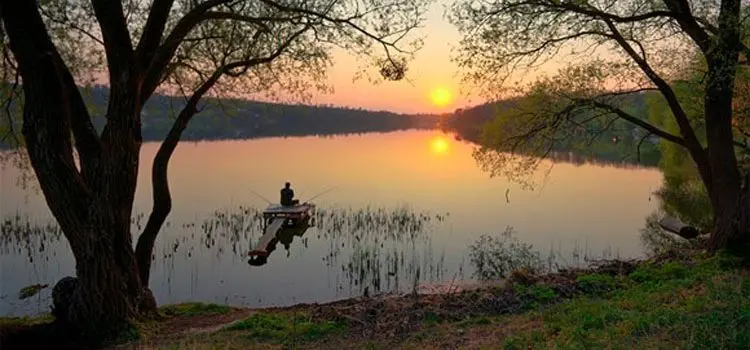
Almost all anglers know that weather conditions greatly affect the bite of fish. At the same time, they noticed that there is weather when the fish are biting very actively and this is the best weather for fishing. As a rule, this is a combination of certain weather conditions that are very difficult to predict.
Basically, the best weather for fishing is not acceptable for anglers., but many of them sacrifice their comfort for the pleasure of intense biting. But, in most cases, in order to know when the fish are biting, you don’t have to get wet in the rain or endure strong gusts of wind, and also be in fog when you can’t even see the float.
Knowing some of the conditions that affect the bite, or rather their combination, you can determine whether the fish will be caught today, and also where exactly it will bite without leaving the pond. So, in this article we will tell you what is the best weather for fishing, as well as what are the factors that determine this weather.
The influence of certain factors on fish biting
You should pay attention to the following indicators:
- Atmosphere pressure;
- the presence of clouds;
- ambient temperature;
- the depth of the reservoir and the transparency of the water;
- the presence of precipitation;
- the presence of a current;
- the presence and direction of the wind.
It makes sense to dwell on each of them in more detail, especially since they make adjustments to fishing. Sometimes there are cases when, by all indications, the fish should not be caught, but it behaves very actively. This means that some of the signs were not taken into account, and visual observations can be misleading. It is hoped that the mystery of fish behavior will be solved and the factors described above will help in this.
Influence of atmospheric pressure
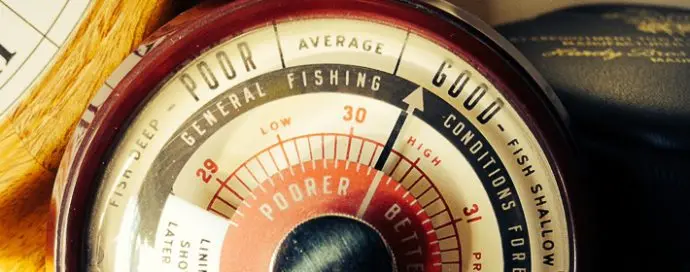
It is believed that this factor most actively affects the behavior of the fish, and hence its biting.. Fish are well caught at constant or decreasing pressure, which indicates a change in the weather for the worse. Fish begin to actively feed if bad weather is expected, especially since they feel the approach of such changes very well. Everything here can be explained by the physiological characteristics associated with the presence of an air bladder in fish. It allows you to properly stay in the water column and move without problems. When the pressure changes, the air bubble ceases to fully fulfill its functions and the fish simply lie on the bottom for a period of bad conditions and stop moving around the reservoir.
During periods of sudden pressure drops, the fish begin to lose their bearings in the water column and find it very difficult to find bait, due to the fact that they cannot correctly assess their location. The fish begins to show the effect of intoxication. Therefore, it ceases to move in the water column, being in certain places at a depth.
Atmospheric pressure should not only be stable, but also have certain indicators. For different reservoirs, these indicators may have different values due to their depth. At the same time, it is considered that the optimal level of atmospheric pressure, which contributes to normal biting, corresponds to 750 mm Hg. But this does not mean that when the pressure reaches this value, the bite is guaranteed. In addition to this factor, there are others.
Cloudiness

The presence of clouds also makes its own adjustments to the behavior of the fish. Depending on whether it is cloudy or cloudless, the fish migrates through the reservoir, changing its location. In hot sunny weather, the fish seeks deeper places with cool water or takes cover in the shade of trees hanging over the water. In such weather, she prefers to be away from direct sunlight. If it was hot for several days, and the sky was cloudless, then when clouds appear, the fish begins to rise from the depths and enter the expanses of water in search of food. The lack of sun increases the level of oxygen in the upper layers of the water. Therefore, on such days, a good bite of fish is possible.
If the weather is cloudy, and even more cold, for several days in a row, then you can hardly count on successful fishing, but with the advent of the first sunny days, the fish swims closer to the surface to bask in the sun.
When the cloudiness is variable, the fish goes to warmer parts of the reservoir, where they spend most of their time. If you choose the right place in such weather, you can count on a good catch.
Air temperature
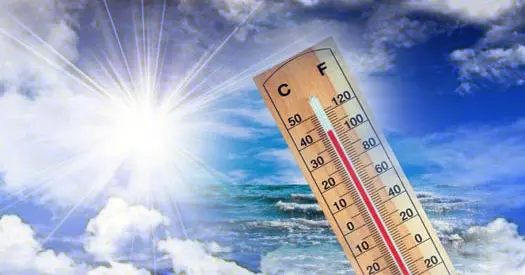
The temperature regime has a huge impact on the activity of the fish, since it belongs to the cold-blooded representatives of the fauna. There is a direct relationship between water temperature and ambient temperature. Since most metabolic processes occur at elevated temperatures, fish begin to feed when the air temperature rises. But the activity of fish is noted within certain temperature limits, and at higher temperatures the fish becomes lethargic and refuses to eat. When the water temperature rises above the optimum, the fish begins to look for places with cooler water, and it begins to feed only from the moment the sun sets. A fish like carp does not show its activity in the daytime, but after sunset and until the morning it actively pecks. Many carp anglers set up their gear to catch him only at night.
During a period of prolonged cooling, the fish may lay low and not be active, but during periods of warming, you can count on productive fishing.
At the same time, a decrease in water temperature causes the predator to eat more, since more energy is needed to move.
In such cases, we can make an unambiguous conclusion: if it gets colder, you can safely go for pike, and if it gets warmer, then you can count on the catch of peaceful fish.
The depth of the reservoir and the purity of the water

The transparency of the water, unequivocally, affects the activity of biting. Clear water allows the fish to examine the bait more closely than muddy water. Therefore, muddy water allows more efficient use of baits that are not of very high quality. For clear water, high-quality baits that do not have a fake game during wiring are more suitable.
At the same time, very muddy water does not allow the fish to quickly find the bait, especially if the fish has poor eyesight. In this case, it is better to use baits that are visible at long distances or baits made from edible silicone. As for peaceful fish, it is able to find bait in troubled waters.
If the water level drops, then the fish refuses to feed. She begins to worry about this circumstance. In such conditions, the fish begins to look for deeper places. This applies to both lakes and rivers. As a rule, small rivers flow into large ones, and large rivers into seas and lakes. Therefore, fish, when the rivers become shallow, roll down to deeper places located on the border of rivers and lakes, as well as rivers and seas.
When the water level rises, the fish begin to show activity. Most likely, this is due to the fact that an increase in the water level is accompanied by an improvement in its characteristics: the saturation of water with oxygen increases, and its nutritional properties also increase. Rising water levels are usually the result of heavy rains or melting snow, which contributes to the leaching of soil from fields in which there are various bugs and worms. It has been observed that after heavy rains, fish bite will certainly improve.
Influence of precipitation

Precipitation in the summer is rain, which can affect the intensity of the bite in different ways. If it rains in hot weather, then active biting is guaranteed, as it brings the long-awaited coolness and enriches the water with oxygen. In addition, he may bring some food washed out of the coastal soil. It was noticed that in places where rainwater, along with washed soil, enters a river or other body of water, the fish showed very high activity.
If the weather is cold and it rains from time to time, then you should not count on successful fishing. The only type of fish that can become active in such weather is burbot. If it’s cold and rainy outside, then it’s time to go for burbot.
Flow
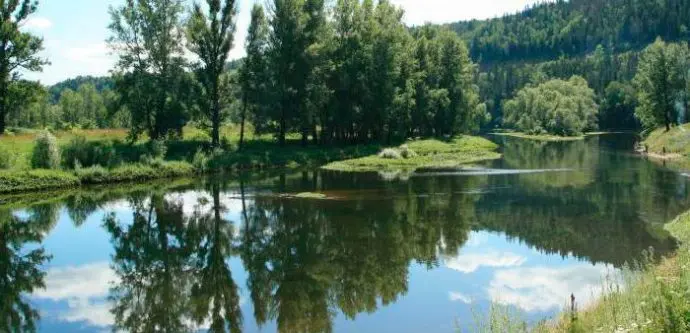
As a rule, the presence of a current in rivers is a constant phenomenon, therefore it does not have a big effect on the bite, although it attracts fish that likes to constantly be in the current. If we take a river as an example, then on it you can find several types of flow, which can have a different direction. This is especially true on rivers that have a complex channel with many bends. Judging by the nature of the current, it is possible to determine the presence of a particular type of fish in a particular area. How active the bite will be is a separate question.
In ponds and lakes, you can also find the movement of water in a reservoir, but only under the influence of external factors, such as wind. Together with the water, the wind carries food elements along the reservoir, which are washed out from the shallows. Fish, as a rule, controls such processes and always accompanies the movement of food particles through the reservoir. From this it follows that the presence of wind, which moves the water masses, contributes to the activation of biting.
Effect of wind on fish bite
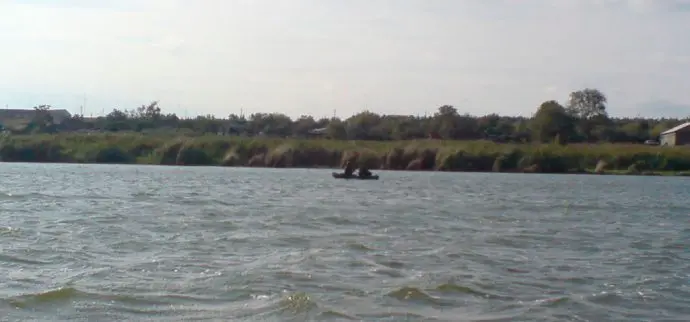
Wind, like all previous factors, can affect the effectiveness of fishing. And here the influence is exerted by two factors – this is the strength of the wind and its direction. As a rule, with the arrival of the wind, comes a change in the weather. What will be the weather, warm and cold, will depend on which part of the world the wind blows. If the wind blows from the south, then most likely the weather will be warm, and if from the north, then cold. The wind that drives the waves on the reservoir very quickly mixes the upper layers. This means that a warm south wind can increase the temperature of the upper layers of the water, and a cold north wind will make them colder.
A cold north wind can positively affect the bite after a long heat wave, and a warm south wind after a long cold snap.
The strength of the wind also makes its own adjustments. When the wind is not strong, when weak ripples are visible on the surface of the water, the fish behaves more naturally, since they cannot see what is happening on the shore. This circumstance can be used by the angler, as the fish feels safe. In the presence of a strong wind, one can hardly count on normal fishing, since the waves shake the tackle, and this alarms the fish. Everything comes into motion, including the bait on the hook, and the feeder with bait.
You can count on good fishing after the wind stops. Waves, hitting the shore, wash out food and such fish as bream will definitely come to the shore to feed. For anglers, this is just the case when you can catch a good bream.
If you add all these factors together, then you can predict the behavior of the fish, which is what experienced anglers do. In this case, going outside early in the morning, you can determine by the direction of the wind whether it is worth going fishing today. Despite this, there is a category of anglers who do not pay much attention to various factors and still go fishing. Such fishermen do not go for fish, but go to the reservoir to rest in order to get another boost of vivacity. Moreover, weekends do not fit in with the weather conditions and they are not similar to each other.
But there is another category of anglers who go fishing only on promising days. To do this, many have adopted the Internet, which indicates the weather forecast for the coming days, indicating atmospheric pressure, air temperature and wind direction. If this day is working, then you can take a day off, and if the fisherman is a pensioner, then he has no barriers to go fishing on the right day.
Forecasting the activity of biting is a complex and ambiguous process that only experienced and purposeful fishermen can do. As a rule, the difficulty lies in putting all the circumstances together.
Influence of atmospheric pressure, temperature, wind, cloudiness, precipitation on fish biting









